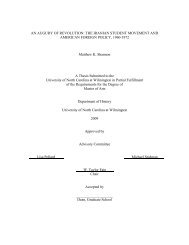HIERARCHAL INDUCTIVE PROCESS MODELING AND ANALYSIS ...
HIERARCHAL INDUCTIVE PROCESS MODELING AND ANALYSIS ...
HIERARCHAL INDUCTIVE PROCESS MODELING AND ANALYSIS ...
You also want an ePaper? Increase the reach of your titles
YUMPU automatically turns print PDFs into web optimized ePapers that Google loves.
experiment 22, yielding no good fit models under 1 reMSE cutoff. Another case<br />
that is cause for worry is the one where time-series are given to all 5 entities which<br />
we would expect to have at least one model selected in between the 0.1 to 1 range<br />
of reMSE cutoff. This observation raises the question that there may be an underlying<br />
issue with the model selection process. Incidentally, all of the combinations<br />
that yield no models under the 1 reMSE cutoff are experiments to which we gave<br />
Z a time-series constraint, which may say something about the processes that drive<br />
zooplankton; the library may be in need of improvements.<br />
3.3 Summary<br />
This result analysis allows us to make the following observations:<br />
• In most cases, increasing the number of time-series constraints up to 3 seemed<br />
to reduce the number of good fit models under a 0.5 cutoff. If we consider<br />
experiments 1 through 25, there was only one case (experiment 20) for which<br />
the number of good fit models increased and six cases for which the number of<br />
good fit models went to zero (experiment 12, 16,17,18, 22, 23) which can been<br />
interpreted as a deficiency in the library. Overall, this result is due to the fact<br />
that the reMSE is an average of the fit of all the state variables for which we<br />
have time-series.<br />
• The decision as to which data to collect next should take into consideration the<br />
previously acquired time-series. Recommendations may differ based on state<br />
variables previously measured and used with HIPM in the model selection<br />
process. The reason for this is once again the way the reMSE is calculated.<br />
Indeed, depending on how well the previously included time-series fitted a<br />
particular model will determine whether or not the addition of another timeseries<br />
will throw the said model in or out of the pool of good fit models.<br />
30
















